Business and the Business Environment Analysis Report for Sainsbury's
VerifiedAdded on 2023/01/03
|13
|3818
|81
Report
AI Summary
This report provides a comprehensive analysis of the business environment, focusing on the context of Sainsbury's, a major UK supermarket chain. It begins by defining the business environment and categorizing different types of organizations, including public, private, and voluntary sectors, highlighting their distinct purposes and legal structures. The report then delves into the size and scope of various organizations, differentiating them based on factors such as size, scope, and objectives. A significant portion of the report is dedicated to examining the relationship between different organizational functions like marketing, finance, human resources, operations, and IT, emphasizing their interdependencies in achieving organizational objectives. Furthermore, the report explores the impact of the macro environment, including political, economic, social, and technological factors, on business operations, providing examples of how these factors affect companies like Sainsbury's and ASDA. Finally, the report conducts an internal analysis, identifying strengths and weaknesses and linking these to external factors to offer a holistic view of the business environment and its influence on organizational strategy and performance.
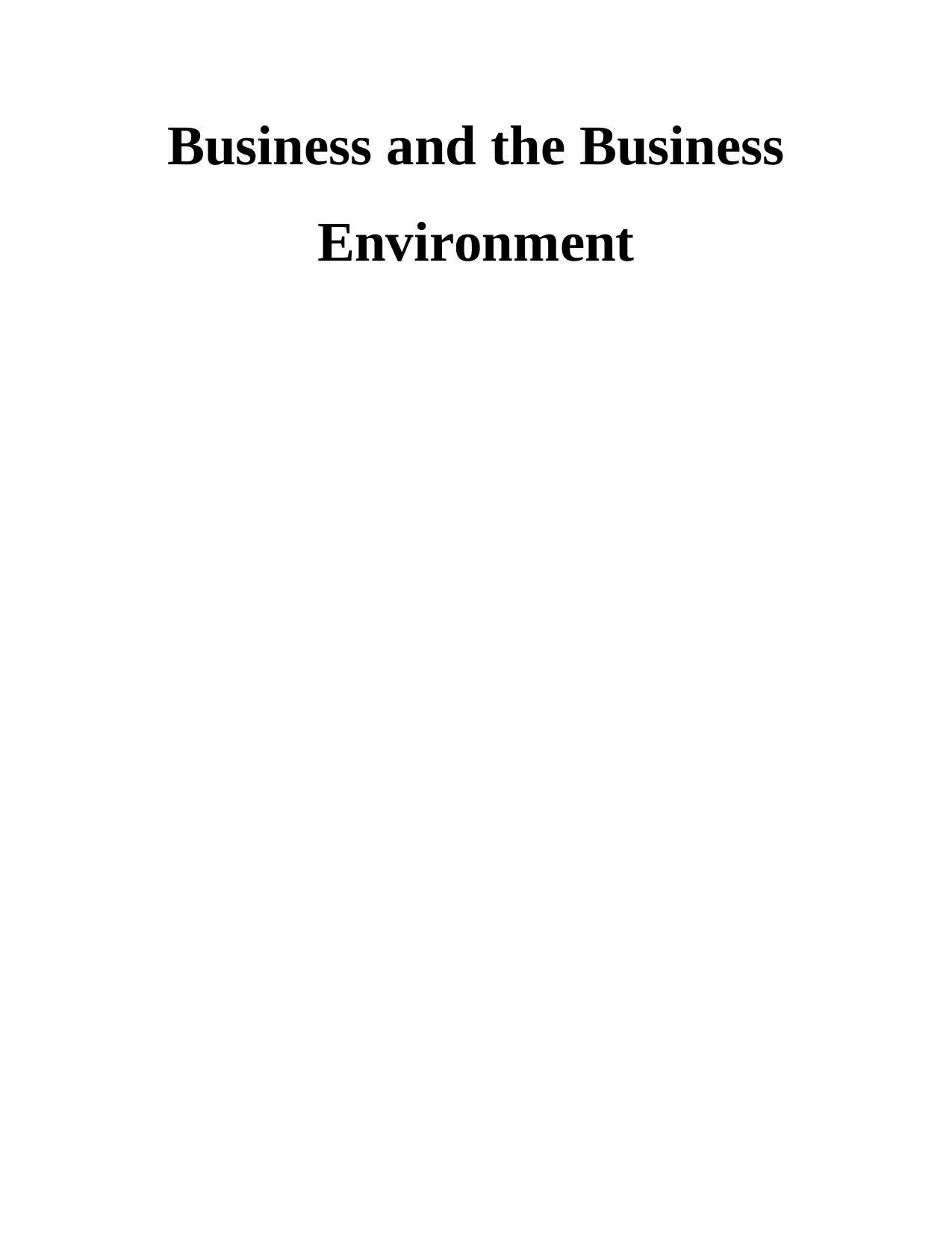
Business and the Business
Environment
Environment
Paraphrase This Document
Need a fresh take? Get an instant paraphrase of this document with our AI Paraphraser
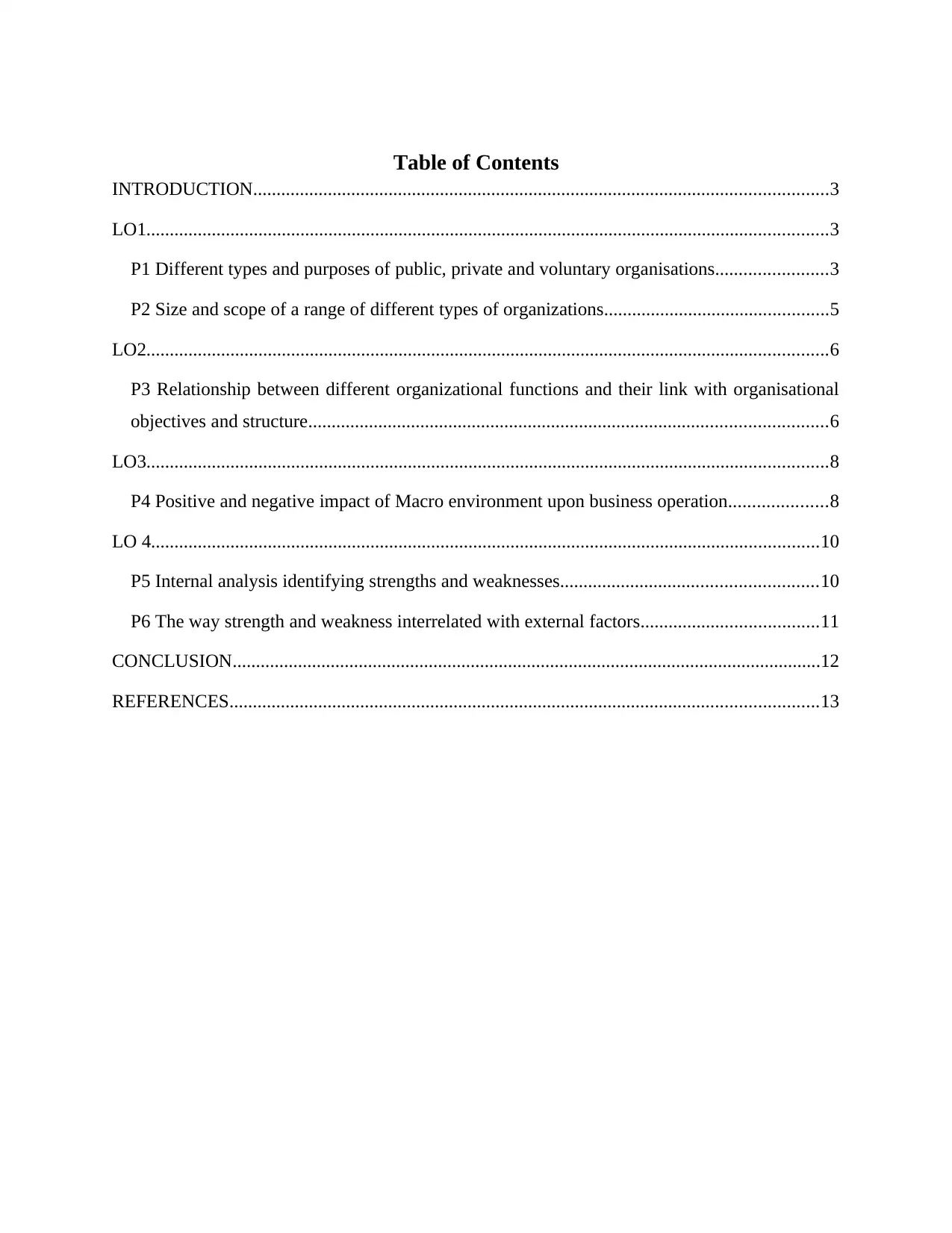
Table of Contents
INTRODUCTION...........................................................................................................................3
LO1..................................................................................................................................................3
P1 Different types and purposes of public, private and voluntary organisations........................3
P2 Size and scope of a range of different types of organizations................................................5
LO2..................................................................................................................................................6
P3 Relationship between different organizational functions and their link with organisational
objectives and structure...............................................................................................................6
LO3..................................................................................................................................................8
P4 Positive and negative impact of Macro environment upon business operation.....................8
LO 4...............................................................................................................................................10
P5 Internal analysis identifying strengths and weaknesses.......................................................10
P6 The way strength and weakness interrelated with external factors......................................11
CONCLUSION..............................................................................................................................12
REFERENCES..............................................................................................................................13
INTRODUCTION...........................................................................................................................3
LO1..................................................................................................................................................3
P1 Different types and purposes of public, private and voluntary organisations........................3
P2 Size and scope of a range of different types of organizations................................................5
LO2..................................................................................................................................................6
P3 Relationship between different organizational functions and their link with organisational
objectives and structure...............................................................................................................6
LO3..................................................................................................................................................8
P4 Positive and negative impact of Macro environment upon business operation.....................8
LO 4...............................................................................................................................................10
P5 Internal analysis identifying strengths and weaknesses.......................................................10
P6 The way strength and weakness interrelated with external factors......................................11
CONCLUSION..............................................................................................................................12
REFERENCES..............................................................................................................................13
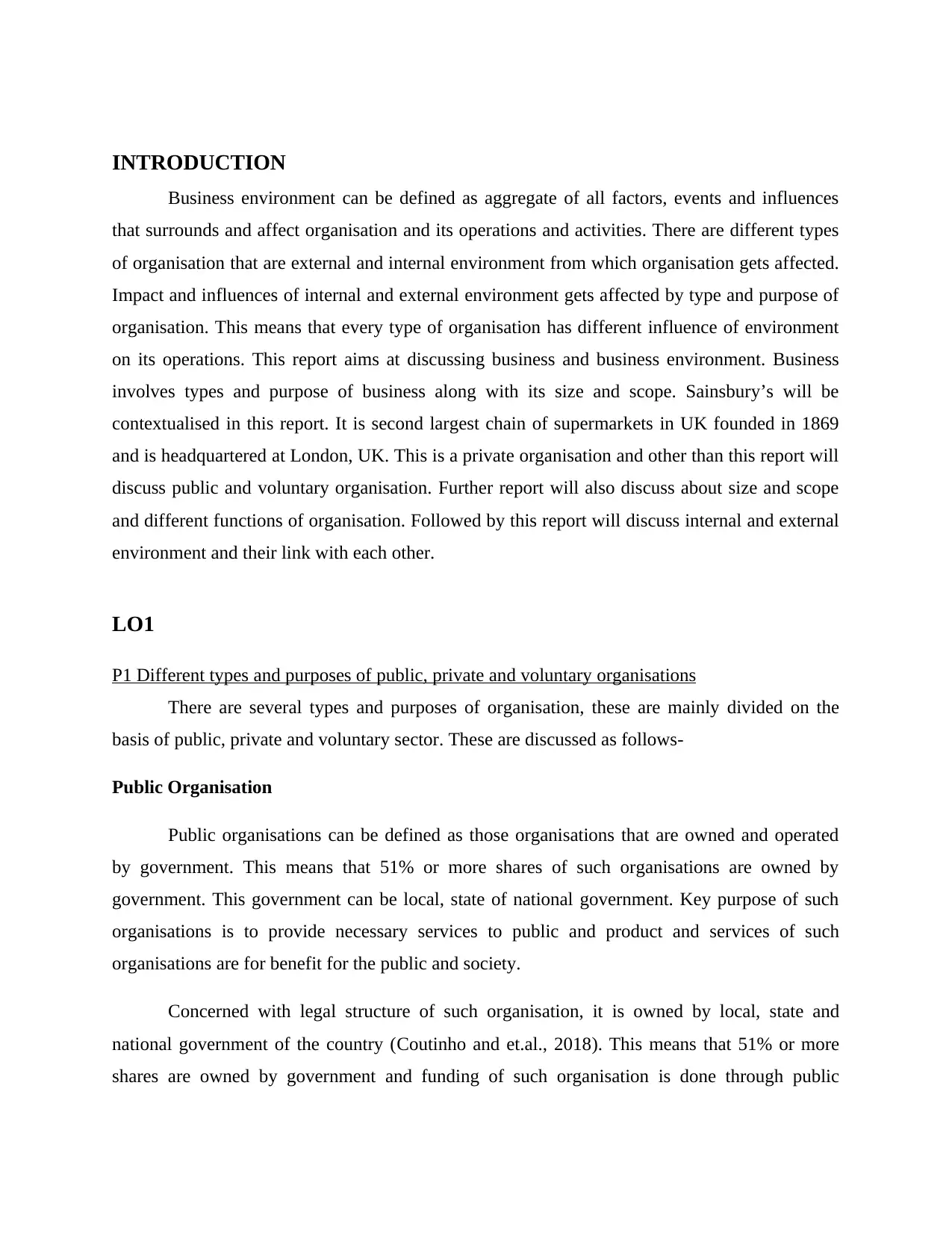
INTRODUCTION
Business environment can be defined as aggregate of all factors, events and influences
that surrounds and affect organisation and its operations and activities. There are different types
of organisation that are external and internal environment from which organisation gets affected.
Impact and influences of internal and external environment gets affected by type and purpose of
organisation. This means that every type of organisation has different influence of environment
on its operations. This report aims at discussing business and business environment. Business
involves types and purpose of business along with its size and scope. Sainsbury’s will be
contextualised in this report. It is second largest chain of supermarkets in UK founded in 1869
and is headquartered at London, UK. This is a private organisation and other than this report will
discuss public and voluntary organisation. Further report will also discuss about size and scope
and different functions of organisation. Followed by this report will discuss internal and external
environment and their link with each other.
LO1
P1 Different types and purposes of public, private and voluntary organisations
There are several types and purposes of organisation, these are mainly divided on the
basis of public, private and voluntary sector. These are discussed as follows-
Public Organisation
Public organisations can be defined as those organisations that are owned and operated
by government. This means that 51% or more shares of such organisations are owned by
government. This government can be local, state of national government. Key purpose of such
organisations is to provide necessary services to public and product and services of such
organisations are for benefit for the public and society.
Concerned with legal structure of such organisation, it is owned by local, state and
national government of the country (Coutinho and et.al., 2018). This means that 51% or more
shares are owned by government and funding of such organisation is done through public
Business environment can be defined as aggregate of all factors, events and influences
that surrounds and affect organisation and its operations and activities. There are different types
of organisation that are external and internal environment from which organisation gets affected.
Impact and influences of internal and external environment gets affected by type and purpose of
organisation. This means that every type of organisation has different influence of environment
on its operations. This report aims at discussing business and business environment. Business
involves types and purpose of business along with its size and scope. Sainsbury’s will be
contextualised in this report. It is second largest chain of supermarkets in UK founded in 1869
and is headquartered at London, UK. This is a private organisation and other than this report will
discuss public and voluntary organisation. Further report will also discuss about size and scope
and different functions of organisation. Followed by this report will discuss internal and external
environment and their link with each other.
LO1
P1 Different types and purposes of public, private and voluntary organisations
There are several types and purposes of organisation, these are mainly divided on the
basis of public, private and voluntary sector. These are discussed as follows-
Public Organisation
Public organisations can be defined as those organisations that are owned and operated
by government. This means that 51% or more shares of such organisations are owned by
government. This government can be local, state of national government. Key purpose of such
organisations is to provide necessary services to public and product and services of such
organisations are for benefit for the public and society.
Concerned with legal structure of such organisation, it is owned by local, state and
national government of the country (Coutinho and et.al., 2018). This means that 51% or more
shares are owned by government and funding of such organisation is done through public
⊘ This is a preview!⊘
Do you want full access?
Subscribe today to unlock all pages.

Trusted by 1+ million students worldwide
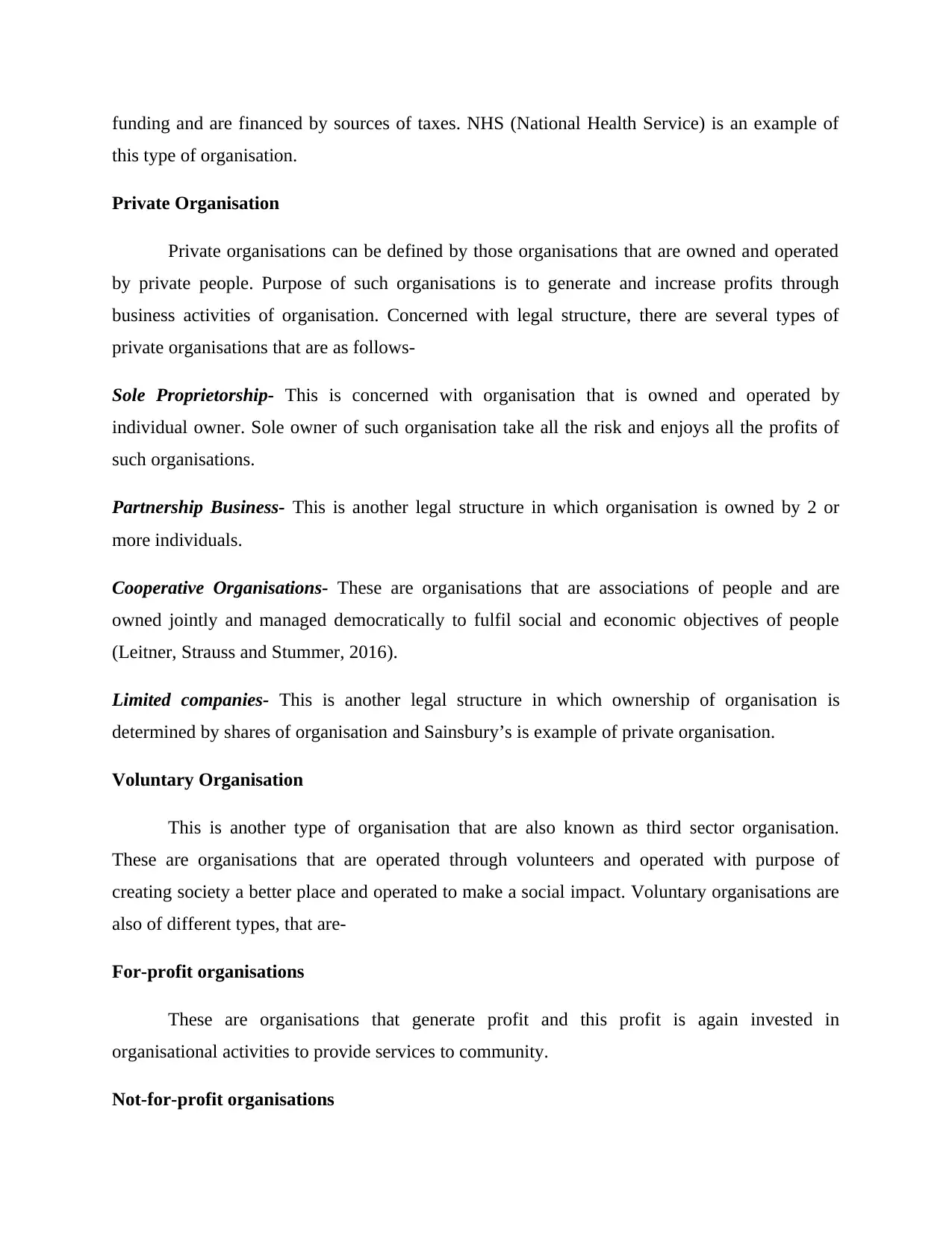
funding and are financed by sources of taxes. NHS (National Health Service) is an example of
this type of organisation.
Private Organisation
Private organisations can be defined by those organisations that are owned and operated
by private people. Purpose of such organisations is to generate and increase profits through
business activities of organisation. Concerned with legal structure, there are several types of
private organisations that are as follows-
Sole Proprietorship- This is concerned with organisation that is owned and operated by
individual owner. Sole owner of such organisation take all the risk and enjoys all the profits of
such organisations.
Partnership Business- This is another legal structure in which organisation is owned by 2 or
more individuals.
Cooperative Organisations- These are organisations that are associations of people and are
owned jointly and managed democratically to fulfil social and economic objectives of people
(Leitner, Strauss and Stummer, 2016).
Limited companies- This is another legal structure in which ownership of organisation is
determined by shares of organisation and Sainsbury’s is example of private organisation.
Voluntary Organisation
This is another type of organisation that are also known as third sector organisation.
These are organisations that are operated through volunteers and operated with purpose of
creating society a better place and operated to make a social impact. Voluntary organisations are
also of different types, that are-
For-profit organisations
These are organisations that generate profit and this profit is again invested in
organisational activities to provide services to community.
Not-for-profit organisations
this type of organisation.
Private Organisation
Private organisations can be defined by those organisations that are owned and operated
by private people. Purpose of such organisations is to generate and increase profits through
business activities of organisation. Concerned with legal structure, there are several types of
private organisations that are as follows-
Sole Proprietorship- This is concerned with organisation that is owned and operated by
individual owner. Sole owner of such organisation take all the risk and enjoys all the profits of
such organisations.
Partnership Business- This is another legal structure in which organisation is owned by 2 or
more individuals.
Cooperative Organisations- These are organisations that are associations of people and are
owned jointly and managed democratically to fulfil social and economic objectives of people
(Leitner, Strauss and Stummer, 2016).
Limited companies- This is another legal structure in which ownership of organisation is
determined by shares of organisation and Sainsbury’s is example of private organisation.
Voluntary Organisation
This is another type of organisation that are also known as third sector organisation.
These are organisations that are operated through volunteers and operated with purpose of
creating society a better place and operated to make a social impact. Voluntary organisations are
also of different types, that are-
For-profit organisations
These are organisations that generate profit and this profit is again invested in
organisational activities to provide services to community.
Not-for-profit organisations
Paraphrase This Document
Need a fresh take? Get an instant paraphrase of this document with our AI Paraphraser
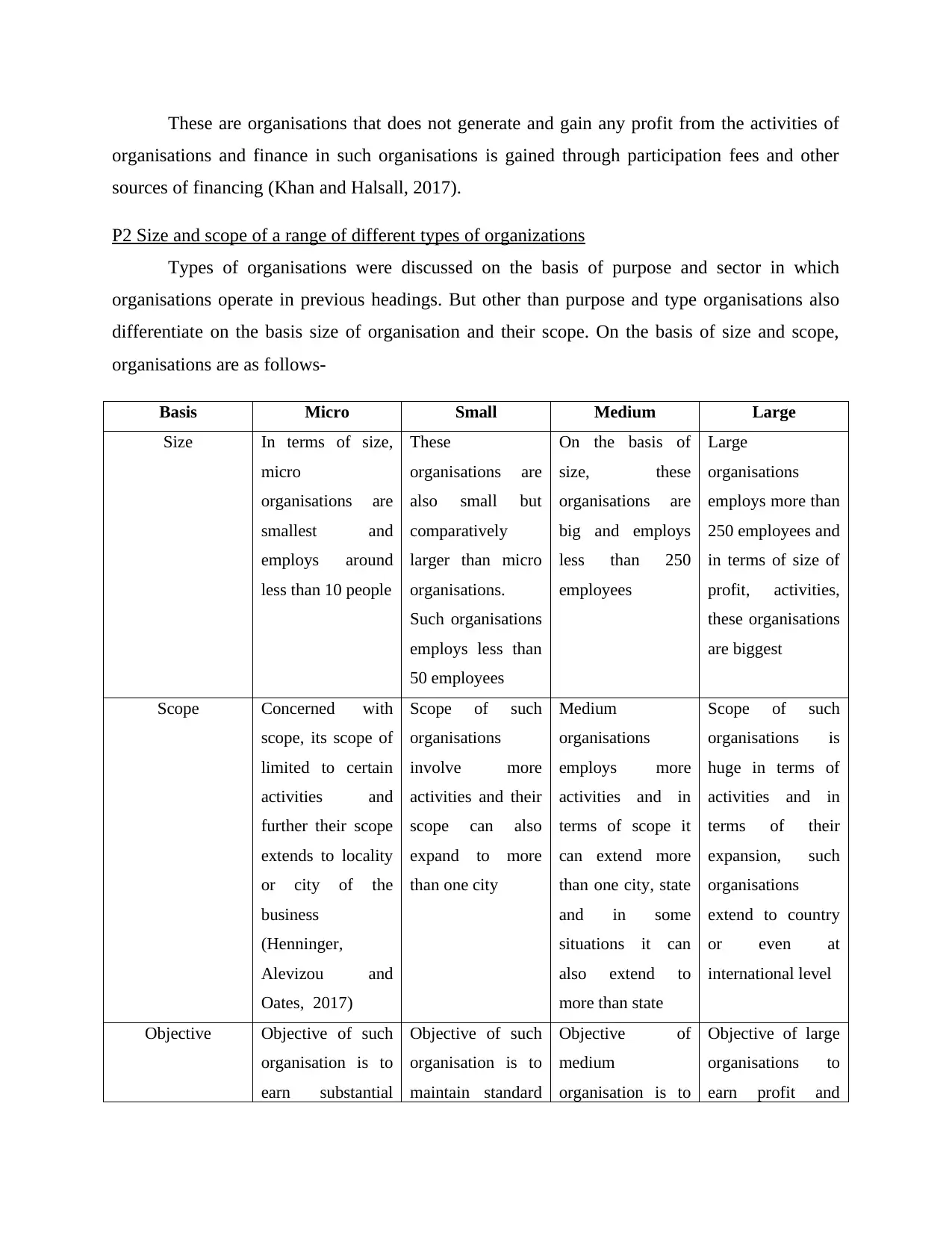
These are organisations that does not generate and gain any profit from the activities of
organisations and finance in such organisations is gained through participation fees and other
sources of financing (Khan and Halsall, 2017).
P2 Size and scope of a range of different types of organizations
Types of organisations were discussed on the basis of purpose and sector in which
organisations operate in previous headings. But other than purpose and type organisations also
differentiate on the basis size of organisation and their scope. On the basis of size and scope,
organisations are as follows-
Basis Micro Small Medium Large
Size In terms of size,
micro
organisations are
smallest and
employs around
less than 10 people
These
organisations are
also small but
comparatively
larger than micro
organisations.
Such organisations
employs less than
50 employees
On the basis of
size, these
organisations are
big and employs
less than 250
employees
Large
organisations
employs more than
250 employees and
in terms of size of
profit, activities,
these organisations
are biggest
Scope Concerned with
scope, its scope of
limited to certain
activities and
further their scope
extends to locality
or city of the
business
(Henninger,
Alevizou and
Oates, 2017)
Scope of such
organisations
involve more
activities and their
scope can also
expand to more
than one city
Medium
organisations
employs more
activities and in
terms of scope it
can extend more
than one city, state
and in some
situations it can
also extend to
more than state
Scope of such
organisations is
huge in terms of
activities and in
terms of their
expansion, such
organisations
extend to country
or even at
international level
Objective Objective of such
organisation is to
earn substantial
Objective of such
organisation is to
maintain standard
Objective of
medium
organisation is to
Objective of large
organisations to
earn profit and
organisations and finance in such organisations is gained through participation fees and other
sources of financing (Khan and Halsall, 2017).
P2 Size and scope of a range of different types of organizations
Types of organisations were discussed on the basis of purpose and sector in which
organisations operate in previous headings. But other than purpose and type organisations also
differentiate on the basis size of organisation and their scope. On the basis of size and scope,
organisations are as follows-
Basis Micro Small Medium Large
Size In terms of size,
micro
organisations are
smallest and
employs around
less than 10 people
These
organisations are
also small but
comparatively
larger than micro
organisations.
Such organisations
employs less than
50 employees
On the basis of
size, these
organisations are
big and employs
less than 250
employees
Large
organisations
employs more than
250 employees and
in terms of size of
profit, activities,
these organisations
are biggest
Scope Concerned with
scope, its scope of
limited to certain
activities and
further their scope
extends to locality
or city of the
business
(Henninger,
Alevizou and
Oates, 2017)
Scope of such
organisations
involve more
activities and their
scope can also
expand to more
than one city
Medium
organisations
employs more
activities and in
terms of scope it
can extend more
than one city, state
and in some
situations it can
also extend to
more than state
Scope of such
organisations is
huge in terms of
activities and in
terms of their
expansion, such
organisations
extend to country
or even at
international level
Objective Objective of such
organisation is to
earn substantial
Objective of such
organisation is to
maintain standard
Objective of
medium
organisation is to
Objective of large
organisations to
earn profit and
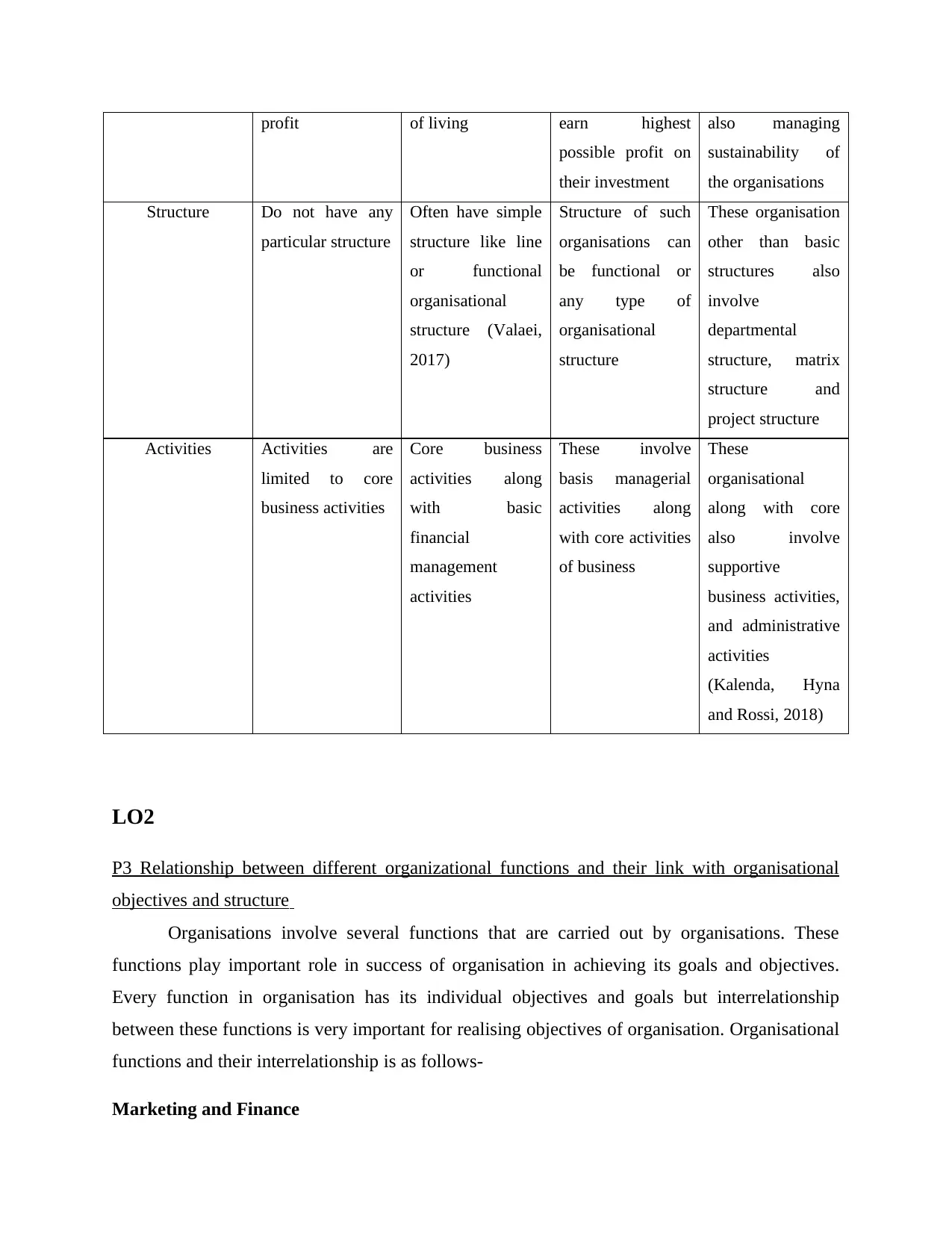
profit of living earn highest
possible profit on
their investment
also managing
sustainability of
the organisations
Structure Do not have any
particular structure
Often have simple
structure like line
or functional
organisational
structure (Valaei,
2017)
Structure of such
organisations can
be functional or
any type of
organisational
structure
These organisation
other than basic
structures also
involve
departmental
structure, matrix
structure and
project structure
Activities Activities are
limited to core
business activities
Core business
activities along
with basic
financial
management
activities
These involve
basis managerial
activities along
with core activities
of business
These
organisational
along with core
also involve
supportive
business activities,
and administrative
activities
(Kalenda, Hyna
and Rossi, 2018)
LO2
P3 Relationship between different organizational functions and their link with organisational
objectives and structure
Organisations involve several functions that are carried out by organisations. These
functions play important role in success of organisation in achieving its goals and objectives.
Every function in organisation has its individual objectives and goals but interrelationship
between these functions is very important for realising objectives of organisation. Organisational
functions and their interrelationship is as follows-
Marketing and Finance
possible profit on
their investment
also managing
sustainability of
the organisations
Structure Do not have any
particular structure
Often have simple
structure like line
or functional
organisational
structure (Valaei,
2017)
Structure of such
organisations can
be functional or
any type of
organisational
structure
These organisation
other than basic
structures also
involve
departmental
structure, matrix
structure and
project structure
Activities Activities are
limited to core
business activities
Core business
activities along
with basic
financial
management
activities
These involve
basis managerial
activities along
with core activities
of business
These
organisational
along with core
also involve
supportive
business activities,
and administrative
activities
(Kalenda, Hyna
and Rossi, 2018)
LO2
P3 Relationship between different organizational functions and their link with organisational
objectives and structure
Organisations involve several functions that are carried out by organisations. These
functions play important role in success of organisation in achieving its goals and objectives.
Every function in organisation has its individual objectives and goals but interrelationship
between these functions is very important for realising objectives of organisation. Organisational
functions and their interrelationship is as follows-
Marketing and Finance
⊘ This is a preview!⊘
Do you want full access?
Subscribe today to unlock all pages.

Trusted by 1+ million students worldwide
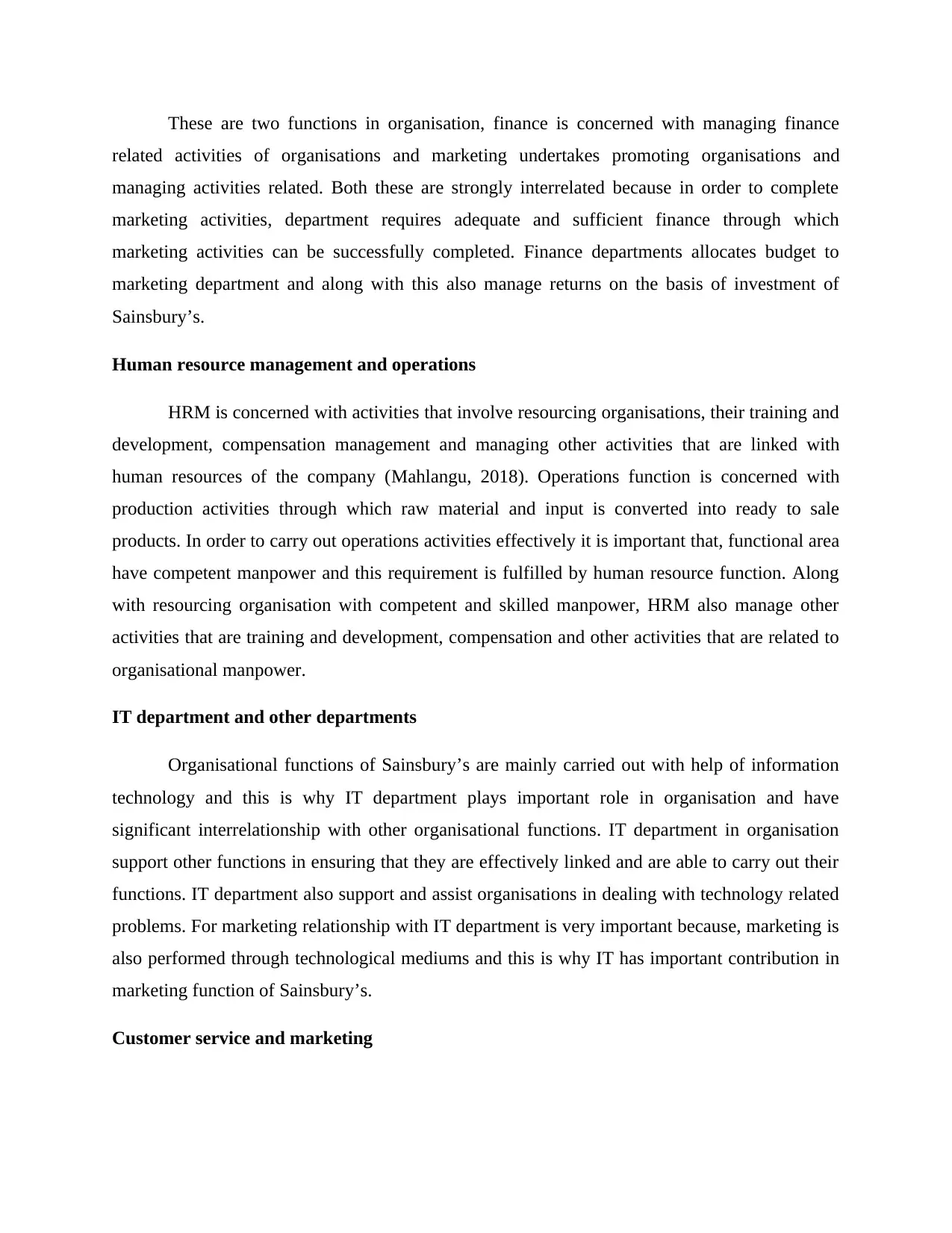
These are two functions in organisation, finance is concerned with managing finance
related activities of organisations and marketing undertakes promoting organisations and
managing activities related. Both these are strongly interrelated because in order to complete
marketing activities, department requires adequate and sufficient finance through which
marketing activities can be successfully completed. Finance departments allocates budget to
marketing department and along with this also manage returns on the basis of investment of
Sainsbury’s.
Human resource management and operations
HRM is concerned with activities that involve resourcing organisations, their training and
development, compensation management and managing other activities that are linked with
human resources of the company (Mahlangu, 2018). Operations function is concerned with
production activities through which raw material and input is converted into ready to sale
products. In order to carry out operations activities effectively it is important that, functional area
have competent manpower and this requirement is fulfilled by human resource function. Along
with resourcing organisation with competent and skilled manpower, HRM also manage other
activities that are training and development, compensation and other activities that are related to
organisational manpower.
IT department and other departments
Organisational functions of Sainsbury’s are mainly carried out with help of information
technology and this is why IT department plays important role in organisation and have
significant interrelationship with other organisational functions. IT department in organisation
support other functions in ensuring that they are effectively linked and are able to carry out their
functions. IT department also support and assist organisations in dealing with technology related
problems. For marketing relationship with IT department is very important because, marketing is
also performed through technological mediums and this is why IT has important contribution in
marketing function of Sainsbury’s.
Customer service and marketing
related activities of organisations and marketing undertakes promoting organisations and
managing activities related. Both these are strongly interrelated because in order to complete
marketing activities, department requires adequate and sufficient finance through which
marketing activities can be successfully completed. Finance departments allocates budget to
marketing department and along with this also manage returns on the basis of investment of
Sainsbury’s.
Human resource management and operations
HRM is concerned with activities that involve resourcing organisations, their training and
development, compensation management and managing other activities that are linked with
human resources of the company (Mahlangu, 2018). Operations function is concerned with
production activities through which raw material and input is converted into ready to sale
products. In order to carry out operations activities effectively it is important that, functional area
have competent manpower and this requirement is fulfilled by human resource function. Along
with resourcing organisation with competent and skilled manpower, HRM also manage other
activities that are training and development, compensation and other activities that are related to
organisational manpower.
IT department and other departments
Organisational functions of Sainsbury’s are mainly carried out with help of information
technology and this is why IT department plays important role in organisation and have
significant interrelationship with other organisational functions. IT department in organisation
support other functions in ensuring that they are effectively linked and are able to carry out their
functions. IT department also support and assist organisations in dealing with technology related
problems. For marketing relationship with IT department is very important because, marketing is
also performed through technological mediums and this is why IT has important contribution in
marketing function of Sainsbury’s.
Customer service and marketing
Paraphrase This Document
Need a fresh take? Get an instant paraphrase of this document with our AI Paraphraser
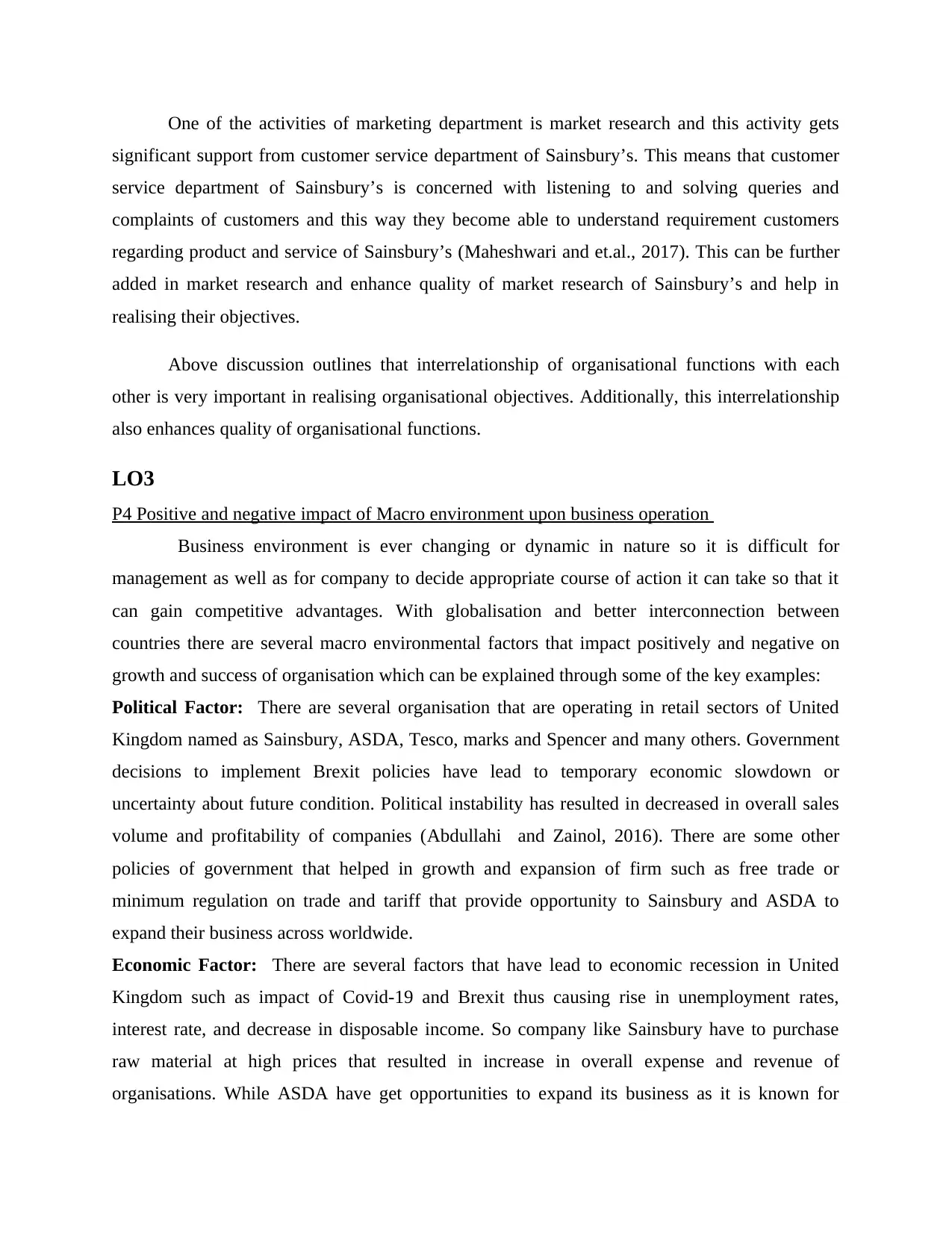
One of the activities of marketing department is market research and this activity gets
significant support from customer service department of Sainsbury’s. This means that customer
service department of Sainsbury’s is concerned with listening to and solving queries and
complaints of customers and this way they become able to understand requirement customers
regarding product and service of Sainsbury’s (Maheshwari and et.al., 2017). This can be further
added in market research and enhance quality of market research of Sainsbury’s and help in
realising their objectives.
Above discussion outlines that interrelationship of organisational functions with each
other is very important in realising organisational objectives. Additionally, this interrelationship
also enhances quality of organisational functions.
LO3
P4 Positive and negative impact of Macro environment upon business operation
Business environment is ever changing or dynamic in nature so it is difficult for
management as well as for company to decide appropriate course of action it can take so that it
can gain competitive advantages. With globalisation and better interconnection between
countries there are several macro environmental factors that impact positively and negative on
growth and success of organisation which can be explained through some of the key examples:
Political Factor: There are several organisation that are operating in retail sectors of United
Kingdom named as Sainsbury, ASDA, Tesco, marks and Spencer and many others. Government
decisions to implement Brexit policies have lead to temporary economic slowdown or
uncertainty about future condition. Political instability has resulted in decreased in overall sales
volume and profitability of companies (Abdullahi and Zainol, 2016). There are some other
policies of government that helped in growth and expansion of firm such as free trade or
minimum regulation on trade and tariff that provide opportunity to Sainsbury and ASDA to
expand their business across worldwide.
Economic Factor: There are several factors that have lead to economic recession in United
Kingdom such as impact of Covid-19 and Brexit thus causing rise in unemployment rates,
interest rate, and decrease in disposable income. So company like Sainsbury have to purchase
raw material at high prices that resulted in increase in overall expense and revenue of
organisations. While ASDA have get opportunities to expand its business as it is known for
significant support from customer service department of Sainsbury’s. This means that customer
service department of Sainsbury’s is concerned with listening to and solving queries and
complaints of customers and this way they become able to understand requirement customers
regarding product and service of Sainsbury’s (Maheshwari and et.al., 2017). This can be further
added in market research and enhance quality of market research of Sainsbury’s and help in
realising their objectives.
Above discussion outlines that interrelationship of organisational functions with each
other is very important in realising organisational objectives. Additionally, this interrelationship
also enhances quality of organisational functions.
LO3
P4 Positive and negative impact of Macro environment upon business operation
Business environment is ever changing or dynamic in nature so it is difficult for
management as well as for company to decide appropriate course of action it can take so that it
can gain competitive advantages. With globalisation and better interconnection between
countries there are several macro environmental factors that impact positively and negative on
growth and success of organisation which can be explained through some of the key examples:
Political Factor: There are several organisation that are operating in retail sectors of United
Kingdom named as Sainsbury, ASDA, Tesco, marks and Spencer and many others. Government
decisions to implement Brexit policies have lead to temporary economic slowdown or
uncertainty about future condition. Political instability has resulted in decreased in overall sales
volume and profitability of companies (Abdullahi and Zainol, 2016). There are some other
policies of government that helped in growth and expansion of firm such as free trade or
minimum regulation on trade and tariff that provide opportunity to Sainsbury and ASDA to
expand their business across worldwide.
Economic Factor: There are several factors that have lead to economic recession in United
Kingdom such as impact of Covid-19 and Brexit thus causing rise in unemployment rates,
interest rate, and decrease in disposable income. So company like Sainsbury have to purchase
raw material at high prices that resulted in increase in overall expense and revenue of
organisations. While ASDA have get opportunities to expand its business as it is known for
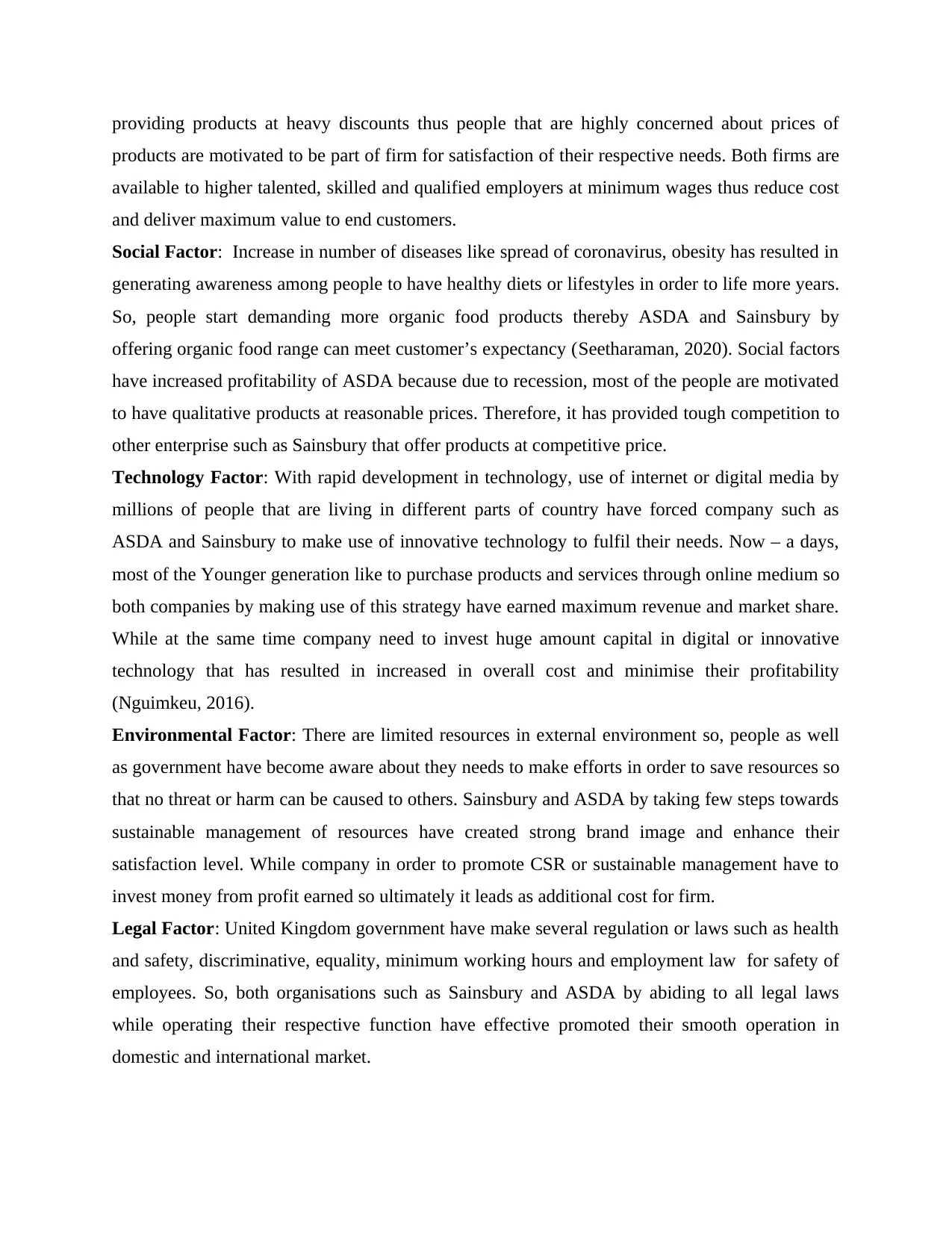
providing products at heavy discounts thus people that are highly concerned about prices of
products are motivated to be part of firm for satisfaction of their respective needs. Both firms are
available to higher talented, skilled and qualified employers at minimum wages thus reduce cost
and deliver maximum value to end customers.
Social Factor: Increase in number of diseases like spread of coronavirus, obesity has resulted in
generating awareness among people to have healthy diets or lifestyles in order to life more years.
So, people start demanding more organic food products thereby ASDA and Sainsbury by
offering organic food range can meet customer’s expectancy (Seetharaman, 2020). Social factors
have increased profitability of ASDA because due to recession, most of the people are motivated
to have qualitative products at reasonable prices. Therefore, it has provided tough competition to
other enterprise such as Sainsbury that offer products at competitive price.
Technology Factor: With rapid development in technology, use of internet or digital media by
millions of people that are living in different parts of country have forced company such as
ASDA and Sainsbury to make use of innovative technology to fulfil their needs. Now – a days,
most of the Younger generation like to purchase products and services through online medium so
both companies by making use of this strategy have earned maximum revenue and market share.
While at the same time company need to invest huge amount capital in digital or innovative
technology that has resulted in increased in overall cost and minimise their profitability
(Nguimkeu, 2016).
Environmental Factor: There are limited resources in external environment so, people as well
as government have become aware about they needs to make efforts in order to save resources so
that no threat or harm can be caused to others. Sainsbury and ASDA by taking few steps towards
sustainable management of resources have created strong brand image and enhance their
satisfaction level. While company in order to promote CSR or sustainable management have to
invest money from profit earned so ultimately it leads as additional cost for firm.
Legal Factor: United Kingdom government have make several regulation or laws such as health
and safety, discriminative, equality, minimum working hours and employment law for safety of
employees. So, both organisations such as Sainsbury and ASDA by abiding to all legal laws
while operating their respective function have effective promoted their smooth operation in
domestic and international market.
products are motivated to be part of firm for satisfaction of their respective needs. Both firms are
available to higher talented, skilled and qualified employers at minimum wages thus reduce cost
and deliver maximum value to end customers.
Social Factor: Increase in number of diseases like spread of coronavirus, obesity has resulted in
generating awareness among people to have healthy diets or lifestyles in order to life more years.
So, people start demanding more organic food products thereby ASDA and Sainsbury by
offering organic food range can meet customer’s expectancy (Seetharaman, 2020). Social factors
have increased profitability of ASDA because due to recession, most of the people are motivated
to have qualitative products at reasonable prices. Therefore, it has provided tough competition to
other enterprise such as Sainsbury that offer products at competitive price.
Technology Factor: With rapid development in technology, use of internet or digital media by
millions of people that are living in different parts of country have forced company such as
ASDA and Sainsbury to make use of innovative technology to fulfil their needs. Now – a days,
most of the Younger generation like to purchase products and services through online medium so
both companies by making use of this strategy have earned maximum revenue and market share.
While at the same time company need to invest huge amount capital in digital or innovative
technology that has resulted in increased in overall cost and minimise their profitability
(Nguimkeu, 2016).
Environmental Factor: There are limited resources in external environment so, people as well
as government have become aware about they needs to make efforts in order to save resources so
that no threat or harm can be caused to others. Sainsbury and ASDA by taking few steps towards
sustainable management of resources have created strong brand image and enhance their
satisfaction level. While company in order to promote CSR or sustainable management have to
invest money from profit earned so ultimately it leads as additional cost for firm.
Legal Factor: United Kingdom government have make several regulation or laws such as health
and safety, discriminative, equality, minimum working hours and employment law for safety of
employees. So, both organisations such as Sainsbury and ASDA by abiding to all legal laws
while operating their respective function have effective promoted their smooth operation in
domestic and international market.
⊘ This is a preview!⊘
Do you want full access?
Subscribe today to unlock all pages.

Trusted by 1+ million students worldwide
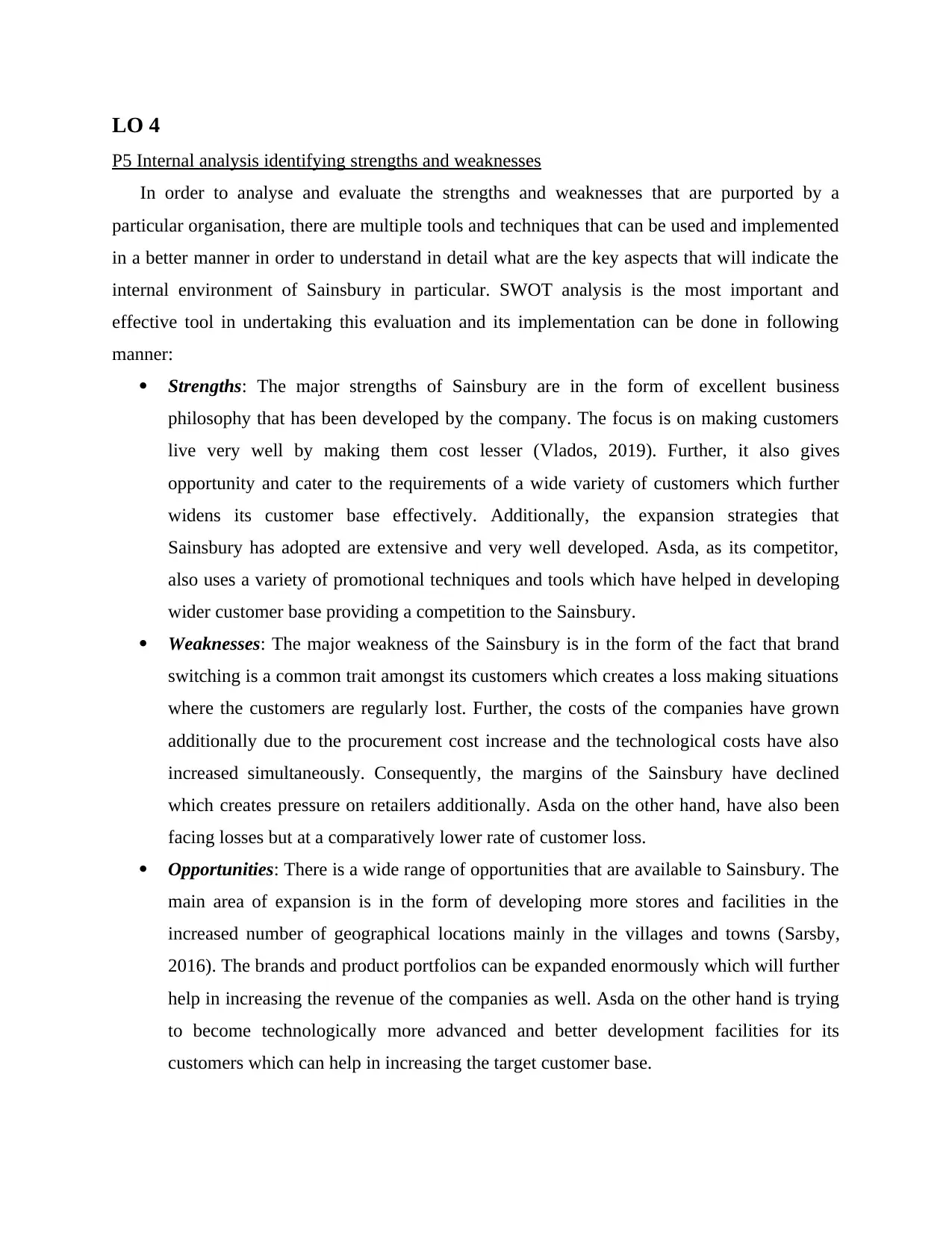
LO 4
P5 Internal analysis identifying strengths and weaknesses
In order to analyse and evaluate the strengths and weaknesses that are purported by a
particular organisation, there are multiple tools and techniques that can be used and implemented
in a better manner in order to understand in detail what are the key aspects that will indicate the
internal environment of Sainsbury in particular. SWOT analysis is the most important and
effective tool in undertaking this evaluation and its implementation can be done in following
manner:
Strengths: The major strengths of Sainsbury are in the form of excellent business
philosophy that has been developed by the company. The focus is on making customers
live very well by making them cost lesser (Vlados, 2019). Further, it also gives
opportunity and cater to the requirements of a wide variety of customers which further
widens its customer base effectively. Additionally, the expansion strategies that
Sainsbury has adopted are extensive and very well developed. Asda, as its competitor,
also uses a variety of promotional techniques and tools which have helped in developing
wider customer base providing a competition to the Sainsbury.
Weaknesses: The major weakness of the Sainsbury is in the form of the fact that brand
switching is a common trait amongst its customers which creates a loss making situations
where the customers are regularly lost. Further, the costs of the companies have grown
additionally due to the procurement cost increase and the technological costs have also
increased simultaneously. Consequently, the margins of the Sainsbury have declined
which creates pressure on retailers additionally. Asda on the other hand, have also been
facing losses but at a comparatively lower rate of customer loss.
Opportunities: There is a wide range of opportunities that are available to Sainsbury. The
main area of expansion is in the form of developing more stores and facilities in the
increased number of geographical locations mainly in the villages and towns (Sarsby,
2016). The brands and product portfolios can be expanded enormously which will further
help in increasing the revenue of the companies as well. Asda on the other hand is trying
to become technologically more advanced and better development facilities for its
customers which can help in increasing the target customer base.
P5 Internal analysis identifying strengths and weaknesses
In order to analyse and evaluate the strengths and weaknesses that are purported by a
particular organisation, there are multiple tools and techniques that can be used and implemented
in a better manner in order to understand in detail what are the key aspects that will indicate the
internal environment of Sainsbury in particular. SWOT analysis is the most important and
effective tool in undertaking this evaluation and its implementation can be done in following
manner:
Strengths: The major strengths of Sainsbury are in the form of excellent business
philosophy that has been developed by the company. The focus is on making customers
live very well by making them cost lesser (Vlados, 2019). Further, it also gives
opportunity and cater to the requirements of a wide variety of customers which further
widens its customer base effectively. Additionally, the expansion strategies that
Sainsbury has adopted are extensive and very well developed. Asda, as its competitor,
also uses a variety of promotional techniques and tools which have helped in developing
wider customer base providing a competition to the Sainsbury.
Weaknesses: The major weakness of the Sainsbury is in the form of the fact that brand
switching is a common trait amongst its customers which creates a loss making situations
where the customers are regularly lost. Further, the costs of the companies have grown
additionally due to the procurement cost increase and the technological costs have also
increased simultaneously. Consequently, the margins of the Sainsbury have declined
which creates pressure on retailers additionally. Asda on the other hand, have also been
facing losses but at a comparatively lower rate of customer loss.
Opportunities: There is a wide range of opportunities that are available to Sainsbury. The
main area of expansion is in the form of developing more stores and facilities in the
increased number of geographical locations mainly in the villages and towns (Sarsby,
2016). The brands and product portfolios can be expanded enormously which will further
help in increasing the revenue of the companies as well. Asda on the other hand is trying
to become technologically more advanced and better development facilities for its
customers which can help in increasing the target customer base.
Paraphrase This Document
Need a fresh take? Get an instant paraphrase of this document with our AI Paraphraser
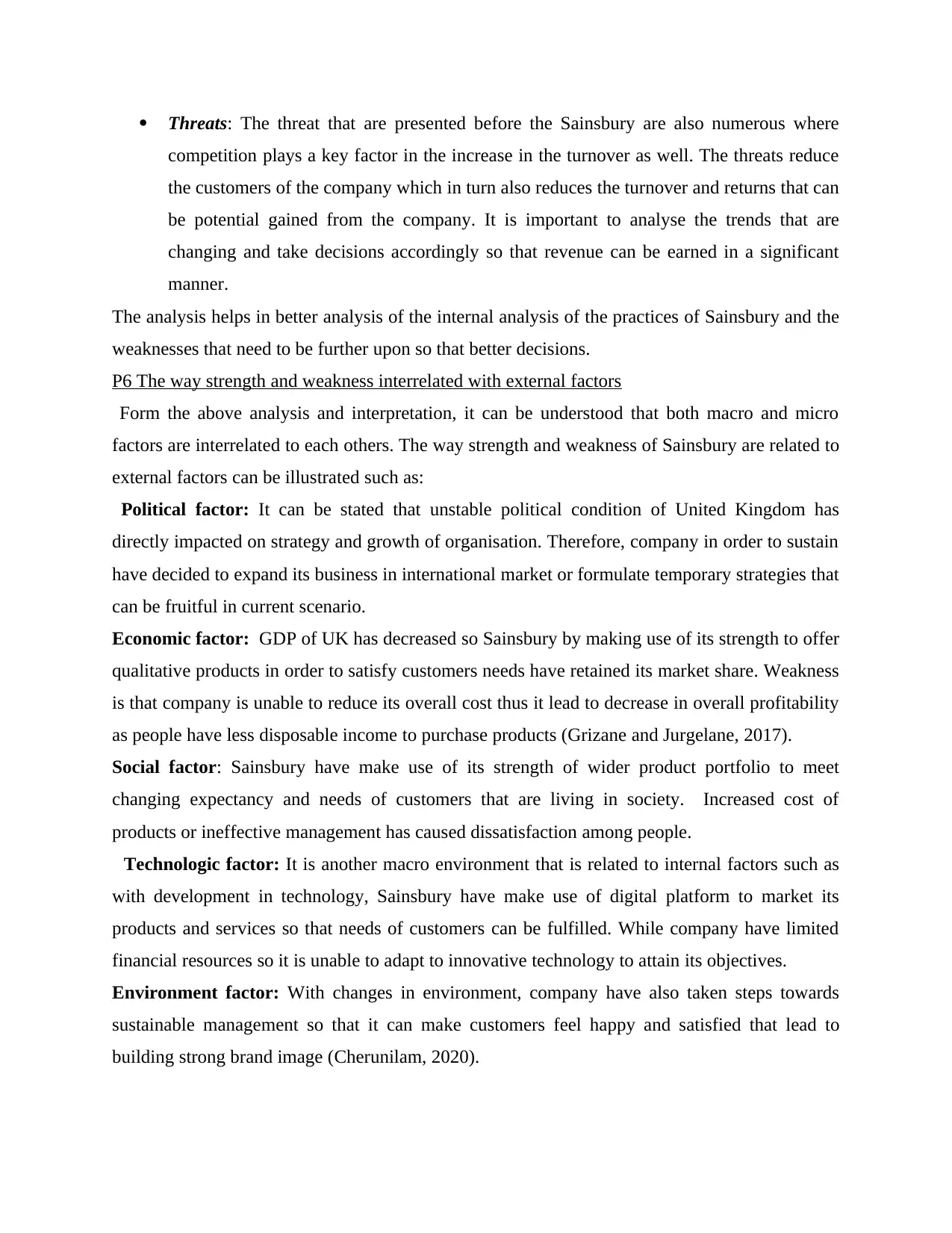
Threats: The threat that are presented before the Sainsbury are also numerous where
competition plays a key factor in the increase in the turnover as well. The threats reduce
the customers of the company which in turn also reduces the turnover and returns that can
be potential gained from the company. It is important to analyse the trends that are
changing and take decisions accordingly so that revenue can be earned in a significant
manner.
The analysis helps in better analysis of the internal analysis of the practices of Sainsbury and the
weaknesses that need to be further upon so that better decisions.
P6 The way strength and weakness interrelated with external factors
Form the above analysis and interpretation, it can be understood that both macro and micro
factors are interrelated to each others. The way strength and weakness of Sainsbury are related to
external factors can be illustrated such as:
Political factor: It can be stated that unstable political condition of United Kingdom has
directly impacted on strategy and growth of organisation. Therefore, company in order to sustain
have decided to expand its business in international market or formulate temporary strategies that
can be fruitful in current scenario.
Economic factor: GDP of UK has decreased so Sainsbury by making use of its strength to offer
qualitative products in order to satisfy customers needs have retained its market share. Weakness
is that company is unable to reduce its overall cost thus it lead to decrease in overall profitability
as people have less disposable income to purchase products (Grizane and Jurgelane, 2017).
Social factor: Sainsbury have make use of its strength of wider product portfolio to meet
changing expectancy and needs of customers that are living in society. Increased cost of
products or ineffective management has caused dissatisfaction among people.
Technologic factor: It is another macro environment that is related to internal factors such as
with development in technology, Sainsbury have make use of digital platform to market its
products and services so that needs of customers can be fulfilled. While company have limited
financial resources so it is unable to adapt to innovative technology to attain its objectives.
Environment factor: With changes in environment, company have also taken steps towards
sustainable management so that it can make customers feel happy and satisfied that lead to
building strong brand image (Cherunilam, 2020).
competition plays a key factor in the increase in the turnover as well. The threats reduce
the customers of the company which in turn also reduces the turnover and returns that can
be potential gained from the company. It is important to analyse the trends that are
changing and take decisions accordingly so that revenue can be earned in a significant
manner.
The analysis helps in better analysis of the internal analysis of the practices of Sainsbury and the
weaknesses that need to be further upon so that better decisions.
P6 The way strength and weakness interrelated with external factors
Form the above analysis and interpretation, it can be understood that both macro and micro
factors are interrelated to each others. The way strength and weakness of Sainsbury are related to
external factors can be illustrated such as:
Political factor: It can be stated that unstable political condition of United Kingdom has
directly impacted on strategy and growth of organisation. Therefore, company in order to sustain
have decided to expand its business in international market or formulate temporary strategies that
can be fruitful in current scenario.
Economic factor: GDP of UK has decreased so Sainsbury by making use of its strength to offer
qualitative products in order to satisfy customers needs have retained its market share. Weakness
is that company is unable to reduce its overall cost thus it lead to decrease in overall profitability
as people have less disposable income to purchase products (Grizane and Jurgelane, 2017).
Social factor: Sainsbury have make use of its strength of wider product portfolio to meet
changing expectancy and needs of customers that are living in society. Increased cost of
products or ineffective management has caused dissatisfaction among people.
Technologic factor: It is another macro environment that is related to internal factors such as
with development in technology, Sainsbury have make use of digital platform to market its
products and services so that needs of customers can be fulfilled. While company have limited
financial resources so it is unable to adapt to innovative technology to attain its objectives.
Environment factor: With changes in environment, company have also taken steps towards
sustainable management so that it can make customers feel happy and satisfied that lead to
building strong brand image (Cherunilam, 2020).
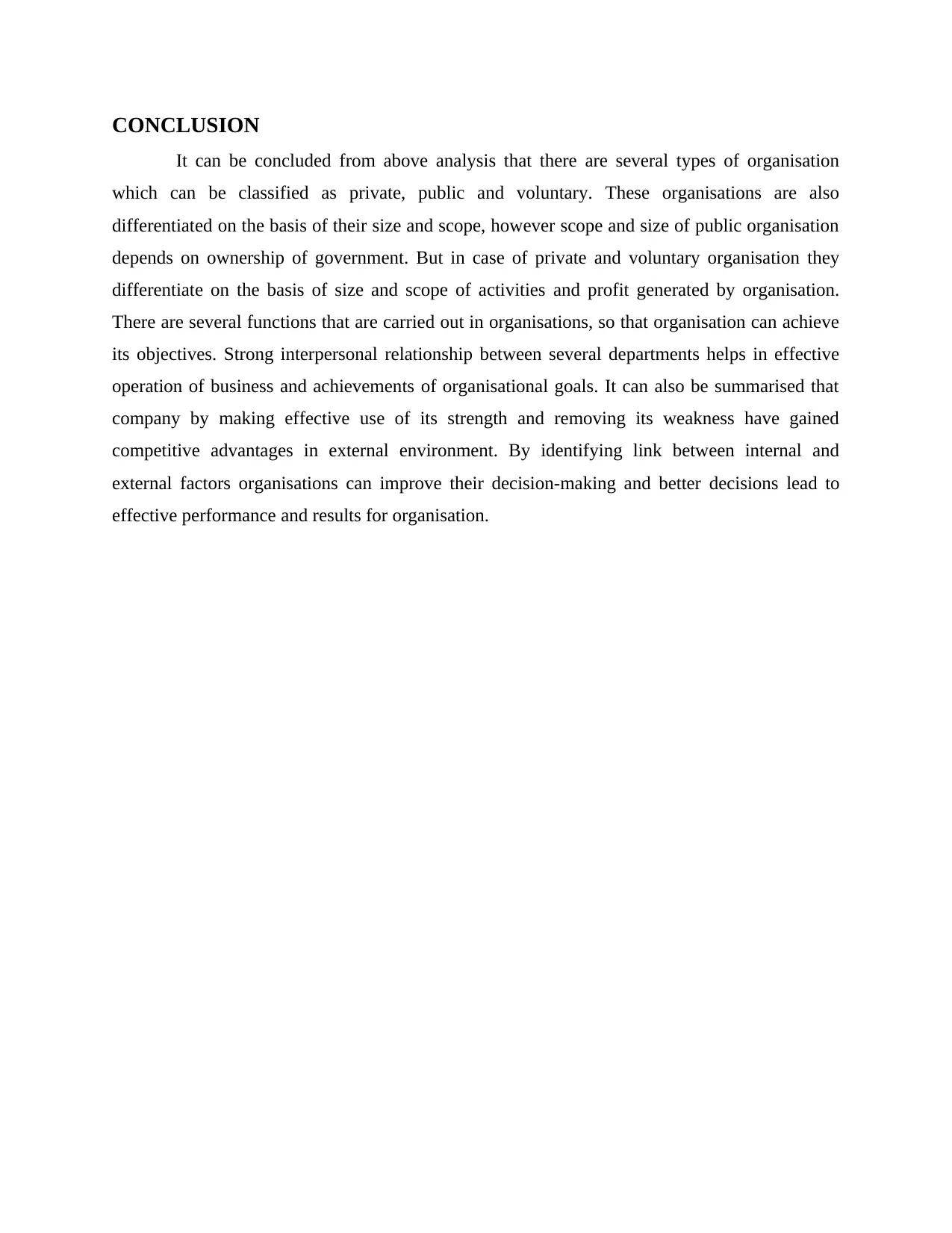
CONCLUSION
It can be concluded from above analysis that there are several types of organisation
which can be classified as private, public and voluntary. These organisations are also
differentiated on the basis of their size and scope, however scope and size of public organisation
depends on ownership of government. But in case of private and voluntary organisation they
differentiate on the basis of size and scope of activities and profit generated by organisation.
There are several functions that are carried out in organisations, so that organisation can achieve
its objectives. Strong interpersonal relationship between several departments helps in effective
operation of business and achievements of organisational goals. It can also be summarised that
company by making effective use of its strength and removing its weakness have gained
competitive advantages in external environment. By identifying link between internal and
external factors organisations can improve their decision-making and better decisions lead to
effective performance and results for organisation.
It can be concluded from above analysis that there are several types of organisation
which can be classified as private, public and voluntary. These organisations are also
differentiated on the basis of their size and scope, however scope and size of public organisation
depends on ownership of government. But in case of private and voluntary organisation they
differentiate on the basis of size and scope of activities and profit generated by organisation.
There are several functions that are carried out in organisations, so that organisation can achieve
its objectives. Strong interpersonal relationship between several departments helps in effective
operation of business and achievements of organisational goals. It can also be summarised that
company by making effective use of its strength and removing its weakness have gained
competitive advantages in external environment. By identifying link between internal and
external factors organisations can improve their decision-making and better decisions lead to
effective performance and results for organisation.
⊘ This is a preview!⊘
Do you want full access?
Subscribe today to unlock all pages.

Trusted by 1+ million students worldwide
1 out of 13
Related Documents
Your All-in-One AI-Powered Toolkit for Academic Success.
+13062052269
info@desklib.com
Available 24*7 on WhatsApp / Email
![[object Object]](/_next/static/media/star-bottom.7253800d.svg)
Unlock your academic potential
Copyright © 2020–2025 A2Z Services. All Rights Reserved. Developed and managed by ZUCOL.




